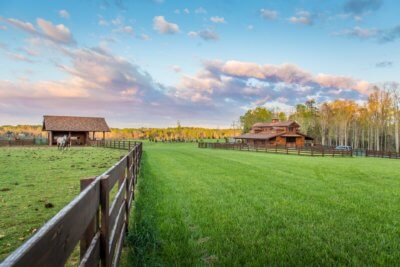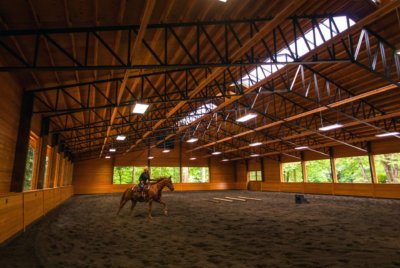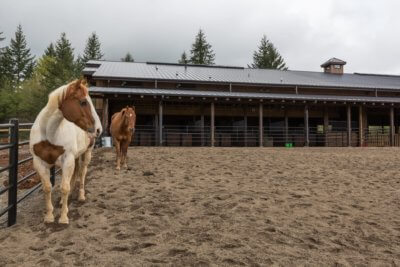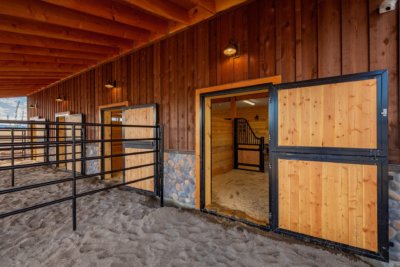I recently came across this post and thought I would share it with my viewers. This is some great information! There is so much to consider when getting into horses. Housing is just one of the many expenses that you will incur, whether you’re remodeling an existing building or putting up a new structure or the cost of boarding your horse. Feeding and caring for your horse is a big job so chore efficiency is of utmost importance. DC Structures has some beautiful buildings for that place you’ve always been dreaming of. A big thanks to DC Structures for letting us share this great information!
~Karen Pickering, Publisher, The Northwest Horse Source.
Any equine enthusiast will agree that horses enrich their lives. Aside from the obvious physical benefits that come with ownership, there are many mental, emotional, and social reasons that make buying a horse a great investment. But when it comes to deciding whether to care for your horses at home or board them at a stable, horse owners have trouble choosing between the two. If you’re still weighing the pros and cons, consider the following pointers.
THE BARE NECESSITIES

How Much Does a Horse Cost?
Caring for a horse can cost anywhere between $200 to $325 per month – an annual average of $3,876, according to finance consulting site Money Crashers. Some of these costs include:
- Grain/feed
- Hay
- Pasture
- Salts/minerals
- Farrier service
- Veterinary care
- Utilities
- Tack and supplies
- Bedding
- Insurance
- Riding lessons
- Truck and trailer purchase
It’s important to consider that boarding costs can drive up these annual projections depending on where you live. For example, it can cost $600 a month to board a horse outside Portland, whereas a farm in a wealthy area of New York might charge $1,300 a month per horse. While a cheaper option, housing a horse on your property comes with a great deal of feeding and daily maintenance that can be physically and financially taxing.
Prior to purchasing a horse, you should create a budget based on how much you anticipate to spend annually on housing and care costs. You can also try to cut costs by shopping for cheap but good-quality hay and learning to trim your horse’s hooves.
How Much Does a Horse Eat?
Every horse is unique and requires a different quantity of food. That being said, a horse’s calories should always come from roughage, meaning good-quality hay or pasture. It’s recommended that horses eat about 1 percent of their body weight in hay or pasture grasses and legumes on a daily basis. Horses that primarily consume hay as their forage typically eat fifteen to twenty pounds of hay per day. A typical 1,000-pound horse fed hay and grain should eat about 20 to 25 pounds a day. Similarly, horses with endless access to a good-quality pasture can eat up to 25 pounds a day. While grass is said to be the most natural and ideal food source for horses, hay is a perfectly good alternative so long as it is the right hay for your horse. Be sure to check out these recommendations for hay and supplements that ensure your horse is kept in good health.
How Often Do Horses Need to Exercise?

As natural grazers, horses need daily exercise. It’s best if owners have a paddock or pasture where horses can nibble and graze throughout the day. On average, horses that are free to move around for most of the day need about 15 to 20 minutes of exercise. Horses kept in stables need at least 30 minutes of exercise on a daily basis.
Depending on the type of work and amount your horse performs, experts also recommend designing a workout that meets your horse’s needs. For instance, if your horse is used for trail riding, their daily workout should include trail riding with speed intervals to build their strength and stamina. Whichever workout routine you decide on, it’s important to be consistent with your horse’s workout schedule. Failure to do so can result in unforeseen injuries caused by re-introducing a horse into a full daily workout without any warm-up.
Grooming Considerations
Grooming is an essential part of owning a horse. Daily grooming helps horses develop a healthy, shiny coat and owners identify any cuts or irritations. Those who ride daily also know that grooming your horse beforehand is a must, considering grit beneath the saddle or girth can irritate your horse’s skin and possibly cause saddle or girth sores. Even if you don’t plan to ride your horse daily, it’s still a good idea to stick to a consistent grooming schedule.
Before grooming your horse, experts recommend having the following items in a wide bucket located in a safe, easy-to-reach area:
- A curry comb or grooming mitt
- Stiff bristled body brush
- A mane and tail comb
- Soft-bristled finishing brush
- Hoof pick
- Clean sponge or soft cloth
- Optional grooming spray, hoof ointment, and scissors
One of the best ways to start grooming is by checking the hooves of your horse for any cracks or changes. You’ll then want to pick out all dirt or anything else in your horse’s hoof. This helps you maintain your horse’s health while effectively removing anything that could prevent you from riding that day.
Then, you’ll want to take your curry comb and start brushing from the neck to the rear. This removes dirt and increases circulation in the skin, which then releases natural oils in your horse’s skin. Afterward, you’ll want to grab your stiff bristled body brush and repeat the same motion, this time using a quick flicking motion to remove any extra hair or dirt. You’ll then take your finishing brush and use long strokes from the neck to the rear to get rid of any remaining dust. You can also use the brush on and around your horse’s face. Lastly, you’ll want to groom the mane and tail by combing small sections from the bottom to top until you can brush the tail from top to bottom without catching any knots.
BOARDING A HORSE

Partials vs. Full Boarding
Horse owners are offered a few options for boarding, the most popular being partial boarding and full boarding.
It’s important to keep in mind that people who partially board their horses will no longer be the horse’s owner. Instead, you pay a portion of the board in order to use the horse for a set number of hours per week and at specific times. Depending on the contract, you could also be responsible for covering veterinarian and farrier fees. Essentially, you can expect to pay less, but with the knowledge that you will have limited access to your horse and cannot maintain ownership.
On the other hand, owners who choose to board their horses full-time can expect to pay more to receive all the benefits of full boarding. This includes unlimited access to their horse and grooming and care services provided by someone else. However, this option can be extremely expensive depending on your location, how many horses you own, and if your board includes lessons, arena, and equipment use. Additionally, owners might be tempted to neglect their horses if they assume they’re getting the best services provided to them. If you decide full boarding is the best option for you, you should plan to check on the horse frequently to make sure it is in good health.
Cost of Boarding a Horse
As mentioned earlier, where you live can determine how expensive boarding costs will be. Expect to pay more if you live close to or in an urban area, as taxes and land costs are typically higher near major cities. Other factors that can drive up costs include competition for the stable, facilities and amenities available, services provided, and costs of traveling to see your horse. If you live close to an urban area and want to board your horse at a well-serviced stable with lessons, you could end up paying over $700 a month. Otherwise, you can find some boards for a dollar a day or perform labor in exchange for partial payments.
HOUSING YOUR OWN HORSE

How Much Land Do You Need?
Those who feel confident in their abilities to care for a horse full-time should consider the amount of land needed in order to keep their horses healthy and happy. This amount can range depending on the number of horses you own, the size of your horse, and management plans. With excellent management, horses can happily graze on as little as one acre but two acres is generally recommended.
Cost of Housing Your Own Horse
In order to house your horse, you’ll likely need your own barn. If you already have your own barn, you’ll want to make sure the facility is in good condition and allows you to care for your horses in a way that’s convenient for you and healthy for them. It’s important to note that the minimum size for a loose box stable is 10’ x 10’ to 12’ x 12’. However, this is passable for riding horses and is not recommended for draft breeds or if you’re expecting a foal.
Those wishing to house their own horses should anticipate the cost of hay, feed concentrate/supplements, bedding, manure removal, water, and utilities for the barn. If you haven’t yet built your barn or plan on moving to a larger plot, you’ll want to calculate your average monthly mortgage payment. All of these costs, plus any additional services you may need or want, can total up to $300 to $400 a month.
Before purchasing your horse, be sure to consider these costs associated with horse ownership so you can properly plan for any unexpected expenses and ensure the well-being of your equine friend.
Be sure to check out the quality buildings by DC Structures and DC Buildings
Images provided by DC Structures
